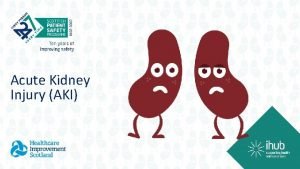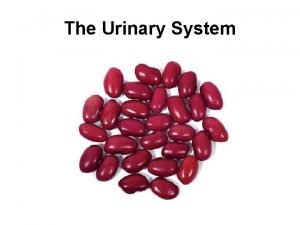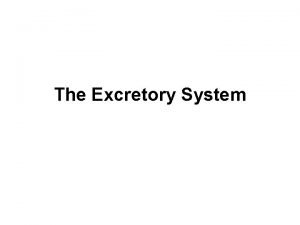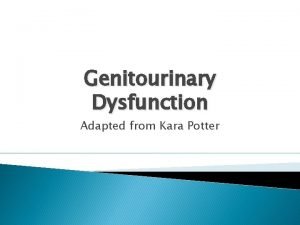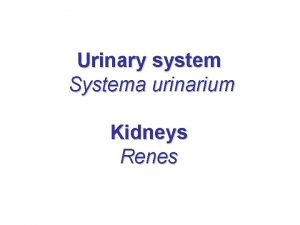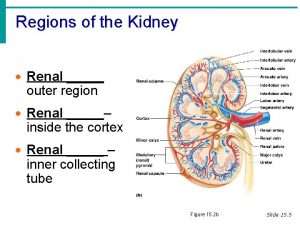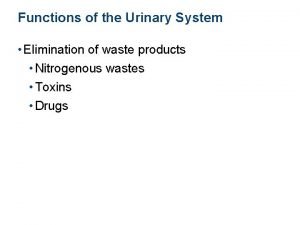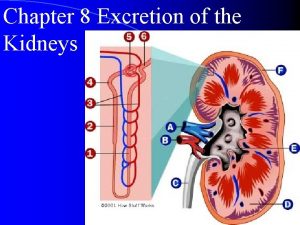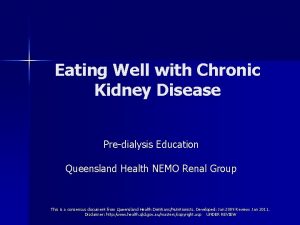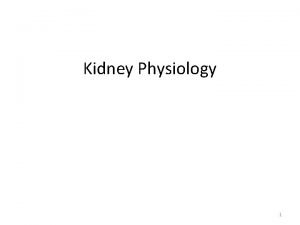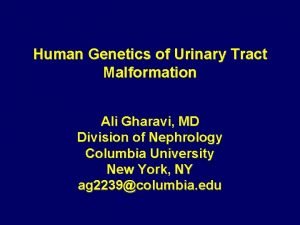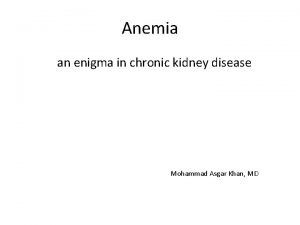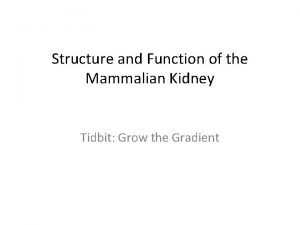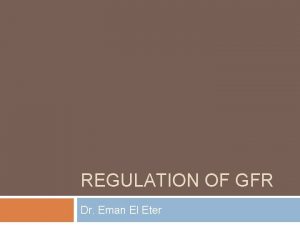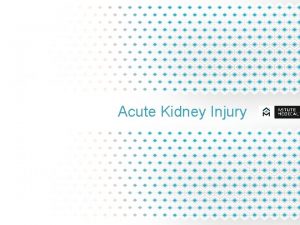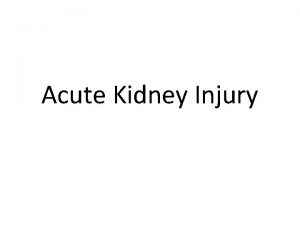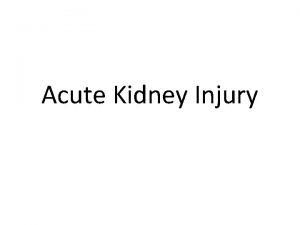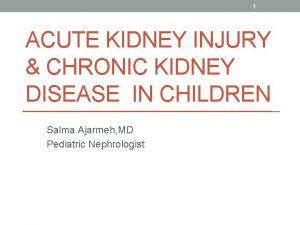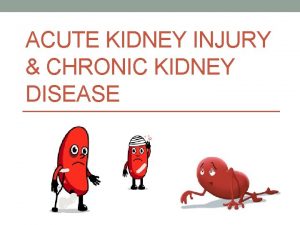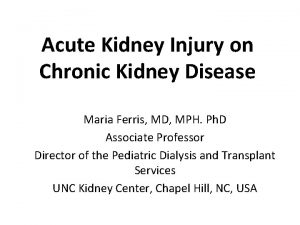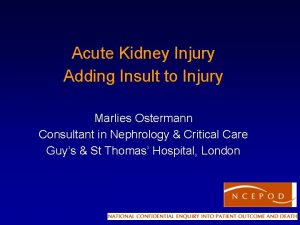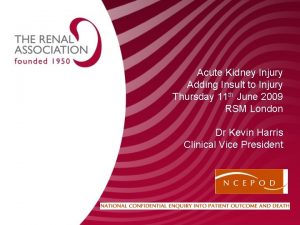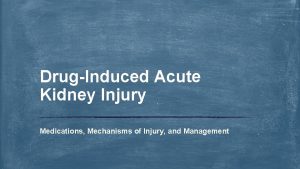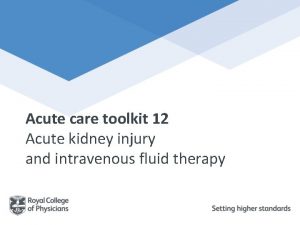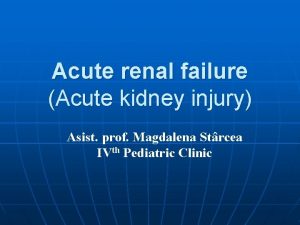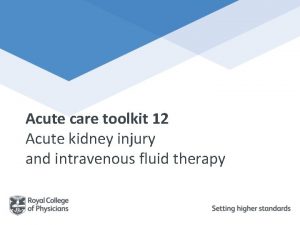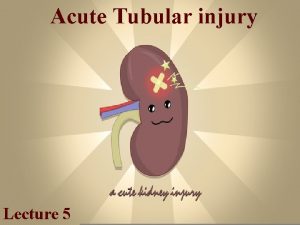Acute Kidney Injury PVHMC FMRP Updated 22020 Instructions




















- Slides: 20

Acute Kidney Injury PVHMC FMRP Updated: 2/2020 Instructions: Pause after a question is presented to discuss as a group before clicking next for answer.

What questions do you ask the patient who has AKI? Fatigue, weakness, encephalopathy/confusion, n/v/diarrhea, bleeding, dizziness, decreased urine output, dyspnea/orthopnea. Any new medications? OTC? NSAIDs? What signs would you see in the patient with AKI? Peripheral edema, suprapubic fullness/tenderness, pulmonary crackles/fluid overload, ascites

What are the KDIGO diagnostic criteria for AKI? 2012 Kidney Disease Improving Global Outcomes (KDIGO) Criteria for diagnosis: 1) Witnessed rise in serum Creatinine >/= 0. 3 mg/dl over 48 hours. 2) Presumed rise in serum Creatinine >/= 50% (1. 5 x) from baseline (can be within 6 -12 months) or within previous 7 days. Example: Today Cr = 1. 8 mg/dl, Baseline Cr = 1. 1 mg/dl. Multiply the baseline Cr by 1. 5 which will give you the 50% increase. 1. 1 mg/dl x 1. 5 = 1. 65, thus today’s Cr of 1. 8 is higher than 1. 5 times the baseline (>/=50%) which meets criteria for AKI. 1) Oliguria with Urine Output of < 0. 5 ml/kg/hr for 6 hours.

What do we document when a patient with CKD has AKI (for CDI)? A/P: 1) AKI on CKD stage 3 secondary to dehydration/poor po intake, improving -Continue with IVF

How do we categorize the 3 types of renal injuries (what are the 3 categories of renal injury)? Pre-Renal injury Intrinsic injury Post-renal injury

What are the causes of Pre-renal AKI? https: //www. aafp. org/afp/2019/1201/p 687. html

What are the causes of Intrinsic renal AKI? https: //www. aafp. org/afp /2019/1201/p 687. html

What are the causes of Post-renal AKI? https: //www. aafp. org/afp/2019/1201/p 687. html

What urine studies can you order? -Urinalysis (UA), Urine eosinophils Acute Tubular Injury = granular casts -AKA Acute Tub Necrosis. It is misnomer as necrosis is usually absent AIN = WBC casts, eosinophils GN = RBC casts -Urine Sodium, Urine Creatinine? ? -Urine Urea? ?

When should we order Fe. NA or Fe. UREA? Do NOT routinely order Fe. NA or Fe. UREA on patients with AKI. The accuracy of these calculations is questionable in setting of CKD, elderly patients, and volume changes (fluids/diuretics they may have received in ER). STILL USE YOUR HISTORY/EXAM/thoughtful clinical assessment which is the gold standard when determining the cause of AKI. FENA does NOT supplant your clinical assessment. See Choosing Wisely article 2016 (Padhwa, Amit, et al. ). If you use Fe. NA/Fe. UREA, then only use it to help support your clinical assessment in prerenal azotemia or AKI in oliguric patients. Use an online calculator/app to help: will need serum sodium/cr, AND urine sodium/cr OR urine sodium/urea: Fe. NA <1% = Pre-renal cause, Fe. NA >2% = Intrinsic Fe. UREA <35% = Pre-renal cause, Fe. UREA >50% = Intrinsic. **If patient takes diuretics (furosemide, HCTZ, etc. ) or received diuretics in ER then Fe. UREA is preferred as those meds can alter urine sodium levels.

What imaging studies can you order? 1) Bedside bladder scan with PVRV (nurse can do this) -place foley if Post Void Residual Volume >200 -300 ml 2) Official Renal/Bladder ultrasound -looking for hydronephrosis, masses, stones. 3) CT guided biopsy of kidney but this should be determined by nephrologist and is not common or routine (GU system bleeds A LOT!)

How do you treat Pre-renal AKI? In general, Isotonic IV Fluids: 0. 9% Normal Saline, Lactated Ringers There is some evidence to prefer Lactated Ringers/balanced crystalloids if AKI is diagnosed in ER as it improves MORTALITY AAFP AKI 2019 Review the causes of Pre-renal injury and treat the cause! When would you NOT give IVF? Do NOT give IVF if your assessment reveals the cause to be cardiac fluid overload/cardiorenal syndrome (peripheral edema, fluid in the lungs) With cardiorenal syndrome, you can do a trial of diuretics/lasix to help perfuse kidneys. The fluid is trapped pre-renal behind the heart (from CHF) and diuretics help to bring that fluid to the kidneys to perfuse and improve the AKI. Sometimes, the fluid can be trapped/third spaced and you could discuss giving IV albumin to try to help mobilize the fluid but this is not routine.

How do you treat Intrinsic renal AKI? 1) In general, trial of IVF and review medications patient exposed to. -Review the causes of Intrinsic AKI on prior slide and investigate/treat the cause. 2) Consult Nephrology. Consider Renal Biopsy (nephro will likely decide if needed) What are some COMMON causes of INTRINSIC AKI? -IV Contrast (usually ATN) -Diuretics -NSAIDS -ACE/ARB -Chemo -Antibiotics (~20% of patients who get Zosyn+Vanco in PVHMC develop AKI, YIKES!!) -Medications in general (review meds) -Rhabdo -Hypotension/hypoperfusion/shock Acute Tubular Injury/Necrosis: generally diagnosed based on how long it takes the AKI to improve. Typically it takes ATN >72 hours to improve. If improves quicker, than likely there’s prerenal cause. ATN carries a much higher illness severity score.

How do you treat Post-renal AKI? 1) Place Foley catheter -SIDE NOTE! Indications for foley: Obstruction, severe AKI and need to monitor strict I&O’s, pelvic wounds that need to avoid moisture and contamination. REMOVE foley otherwise!!! 1) Place ureteral stents (by Urologist) or nephrostomy tubes (by IR or Urologist) if ureters are blocked or if large pelvic mass causing blockage (to relieve the pressure on kidneys). 1) After obstruction is relieved, then IVF to perfuse kidneys

How does AKI affect medication management? AVOID nephrotoxic medications Renally dose all new and old medications

When should you consult nephrology? 1) When there is inadequate response to initial management, ideally within 48 hours as this can benefit patients with AKI if done within 48 hours. 2) When the cause of AKI is unclear, stage 3 or higher AKI, or renal transplant

Can AKI care bundles possibly help to reduce MORTALITY rates? Yes, observational studies show improved mortality with care bundles. See sample from the study to the right -> Kolhe NV, Reilly T, Leung J, et al. A simple care bundle for use in acute kidney injury. Nephrol Dial Transplant. 2016; 31(11): 18461854.

What are the types of dialysis? -Intermittent Hemodialysis -Peritoneal Dialysis -Continuous Renal Replacement Therapy (CRRT): slow removal of fluid over 24 hrs and so can be preferred in patients with hemodynamic instability/hypotension. What are the indications for Dialysis? The indications to the left only really apply if the AKI does not respond to initial conservative treatment. There are NO strict cut off values for when to start HD. Should we start HD early in AKI? One study of patients with AKI and septic shock compared early initiation of renal replacement therapy (within 12 hours) with delayed initiation (48 hours) and found NO difference in 90 -day mortality.

Board Questions

Works Cited 1) AAFP 2019 Acute Kidney Injury 2) Kolhe NV, Reilly T, Leung J, et al. A simple care bundle for use in acute kidney injury. Nephrol Dial Transplant. 2016; 31(11): 1846 -1854. 3) Amit K. Pahwa MD C. John Sperati MD, MHS. Urinary fractional excretion indices in the evaluation of acute kidney injury. Choosing Wisely. First published: 22 December 2015. https: //doi. org/10. 1002/jhm. 2501
 Aki aki aki
Aki aki aki Intentional injury
Intentional injury During _______ branching, only car is updated with adr
During _______ branching, only car is updated with adr Performance monitoring and coaching meaning
Performance monitoring and coaching meaning What are the three regions of the kidney
What are the three regions of the kidney Kidney infection symptoms nhs
Kidney infection symptoms nhs Sighns of kidney disease
Sighns of kidney disease Ren renculisatus
Ren renculisatus The outer region of the kidney
The outer region of the kidney Images of a bladder
Images of a bladder Hydrogen secretion in kidney
Hydrogen secretion in kidney Excretory system diagram
Excretory system diagram Renal medulla
Renal medulla Low potassium diet nemo
Low potassium diet nemo Nephron osmolarity diagram
Nephron osmolarity diagram How to prevent kidney failure
How to prevent kidney failure Hypoplasia
Hypoplasia Kidney
Kidney Tubule
Tubule Gfr rumus
Gfr rumus Non excretory function of kidney
Non excretory function of kidney
